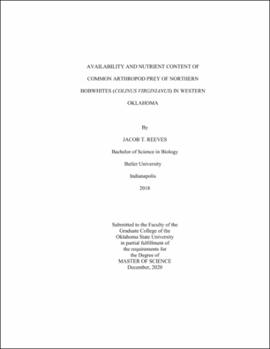| dc.description.abstract | Variation in the relative abundance and biomass of arthropods, as well as individual variation in macronutrient and elemental content, have important potential consequences for insectivores. We studied the influence of seasonality and habitat management (i.e. burning and strip disking) on the availability of potential arthropod prey for brooding northern bobwhites (Colinus virginianus), and tested variation in macronutrient and elemental content between and within common orders of prey. Burning changed the biomass composition of the arthropod community, but disking did not result in any community-level changes. Burning also increased the total abundance and biomass of arthropods collected compared to the control, but disking did not affect total abundance or biomass. Seasonality exerted a broader influence on arthropods, and total abundance and biomass increased throughout the duration of the sampling period (May-July) at burned/paired control and disked/paired control sites. Ants, which had the highest abundance and biomass of any taxa, appeared to drive these patterns. The response of individual orders to management and seasonality varied in size and direction, though we observed more and stronger effects of seasonality than burning or disking. These results support the idea that burning provides benefits to foraging bobwhite broods through increased total availability of arthropod prey, as well as favorable habitat characteristics (i.e. bare ground, structural heterogeneity). However, large seasonal variation in total arthropod abundance and biomass, as well as that of individual orders, likely influences the relative importance of individual prey items in the bobwhite diet based on the timing of nest initiation and hatching, and temporal shifts are particularly important given variation in nutrient content displayed by arthropod taxa. We found that common orders of prey (Hymenoptera and Coleoptera) had high exoskeleton and low protein content, suggesting that the most available prey are also poor quality. Other orders, like Araneae and Orthoptera, had low exoskeleton and high protein content, suggesting that bobwhite chicks benefit from maintaining high diet diversity. Thus, a better understanding of existing variation in arthropod availability and nutrient content is critical for elucidating the role of prey selection and nutrient uptake in shaping the success of avian insectivores. | |
